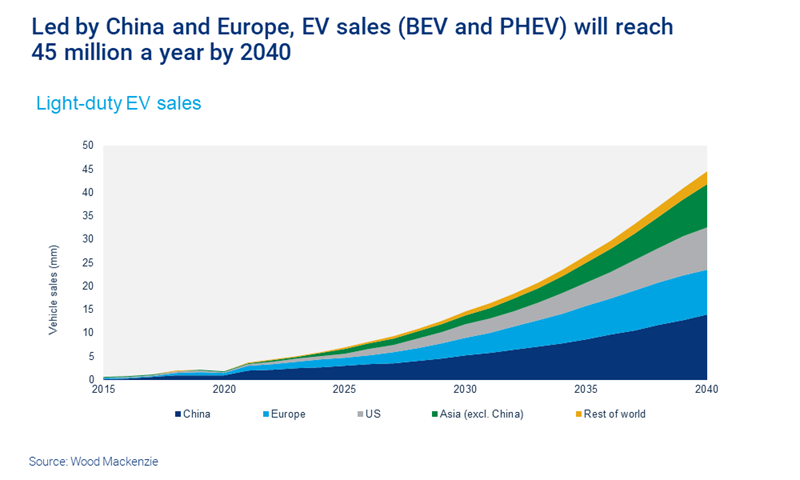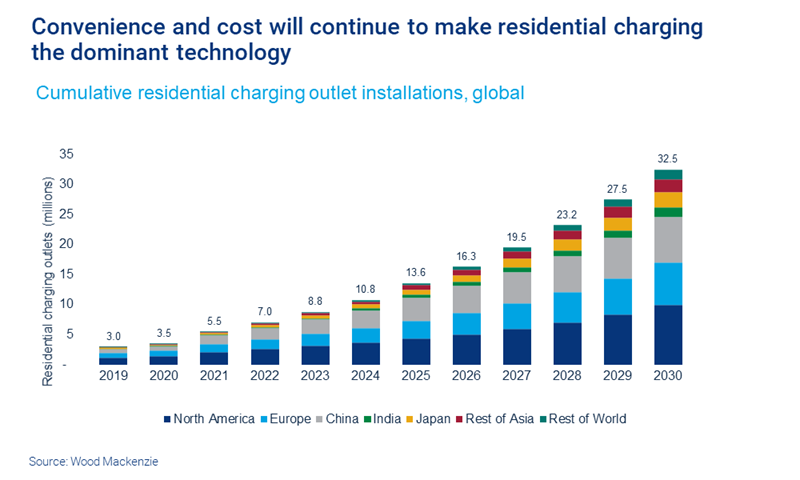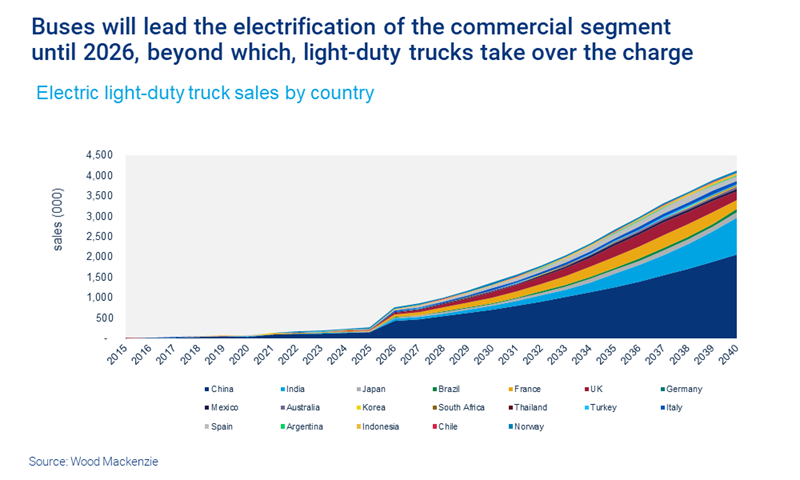Electric vehicles market to get back on track post-Covid-19
EV sales to benefit from governments’ commitments to “green recovery”
1 minute read
Global recession has left a dent in the electric vehicle (EV) sector but it’s a scratch on the paintwork, not a big repair job. We’ve revised down our pre-coronavirus projections for 2040 by 2%, but we still expect the total global EV stock will soar to 323 million over the next 20 years. That’s 35 times the current level.
Our latest long-term outlook shows there are already positive signs of recovery, with EVs taking market share from traditional internal combustion engine (ICE) vehicles.
Sales are rising… but there’s a mixed response from the three largest markets
Despite a coronavirus-led recession, the 2020s still look set to be the decade of the electric vehicle. Total automobile sales, including both ICE and EV, have already started to recover in China, Europe, and the US (the three largest EV markets).
We forecast global sales of battery electric vehicles (BEV) and plug-in hybrids (PHEV) to reach 45 million a year by the end of 2020, with China and Europe leading the way. In both cases, EV adoption has increased in the aftermath of coronavirus, as administrations double down on commitments to a ‘green recovery’.
China is pursuing a strategy to reduce its dependence on oil imports and has extended EV subsidies to the end of 2022. Meanwhile, the EU is incentivising manufacturers with ‘super credits’ to put more zero- or low-emission vehicles on the market.
In the US, however, EV market share has steadily declined since January. Fleet fuel economy targets for auto manufacturers, which would encourage electrification, have been cut by the current administration. The US government is also challenging individual states’ autonomy to set their own vehicle standards – bad news for states like California, that are leading the charge on EV adoption. Policy support for EV is very much dependent on the outcome of November’s presidential election.
What’s happening outside the top three markets? India has seen depressed passenger EV adoption, while Japan leads the fast-charging and vehicle-to-grid technology markets. To download a sample of the EV long-term outlook H1 2020, fill in the form on this page.
The traditional obstacles to adopting electric vehicles are eroding. Range anxiety has historically been a big hurdle for potential EV owners, but charging infrastructure is increasing and becoming more widespread. We forecast residential units will increase ten-fold to 32.5 million over the next decade. Public charging points, meanwhile, will rise from less than 1 million to 5.4 million.
In that time, the number of higher-powered, level-2 chargers (up to 12kWh), which enable cars to charge batteries to travel for longer distances, are set to increase.
Cost is a major consideration when making the switch to EV, and batteries – the most expensive part of the car – are continuing to fall in price. Due to economies of scale and technological improvements, we expect pack prices to drop below the US$100 kWh milestone by 2024, one year earlier than our previous projection.
Are EVs good value for users? According to Wood Mackenzie’s value ratio, EVs in China are more than twice as cost-effective as any other country.
A glimpse into the future – electric trucks
Tesla’s launched its Cybertruck with great fanfare in 2019, giving a glimpse at the next wave of EV adoption.
The commercial EV sector is currently dominated by electric buses, but from 2026 onwards, we expect light-trucks to take the lead. As well as Tesla’s high-profile activities, a particularly hotly contested area is the pick-up truck market. Several new players, including Rivian, Bollinger, Lordstown Motors and Nikola, have received significant funding and each has at least one product set to go on sale in the next two years. Fill in the form on this page to download a sample brochure.
Cost, not regulation, is the major driving factor behind commercial EV adoption. As the total cost of ownership comes down, we expect sales to accelerate from the current comparatively low levels to 5.5 million a year by 2040.
The US pickup truck market sells around 3 million units a year. Find out more about the potential for electrification in this sector in the full long-term EV outlook.
But will electric vehicles help cut carbon?
Several countries put EV adoption at the heart of their plans to cut CO2 emissions. Norway is leading aggressive plans to phase out internal combustion engines (all new light vehicles, city buses and light-commercial vans must be zero-emission by 2025). At the same time, manufacturers such as Toyota and Ford are pushing for supply chains, including dealers, suppliers, and third-party logistics providers to be carbon neutral by 2050.
And yet, the huge growth in the EV sector will only flatten the transport emission curve. It won’t fall. In fact, global CO2 emissions from transport are still set to increase by 1.3 megatons, with more vehicles on the road overall. While objectively greener than their ICE predecessors, battery EVs are not emission-free. The current methods of measuring fuel economy ignore gases produced in the power generation and manufacturing processes.
However, decarbonisation of transport is a vital pillar in reducing emissions. Across all regions, the carbon intensity of power generation is falling, as countries make the switch to greener forms of energy.
EV growth is cutting demand for oil but leading to increased lithium and cobalt mining.
Where to find out more about the long-term outlook for electric vehicles
The Electric Vehicles Long-Term Outlook H1 2020 includes our latest analysis on EV market trends to 2040. It includes global sales forecasts, detailed insight into market drivers and regional dynamics, cost and model trends, and specific focus on specific components of the EV market, such as charging infrastructure and batteries. Fill in the form at the top of this page to download a sample report brochure.








